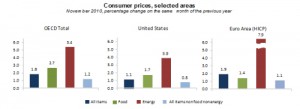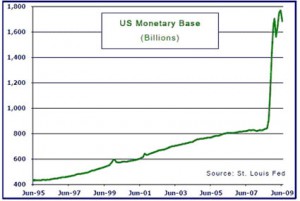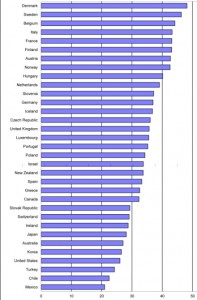The following article from the Organization for Economic Development (OECD), shows a comparison of the inflation rates of several of the major countries. From it, we can see how the U.S. compares. Typically U.S. energy prices are lower than Euro areas and currently energy prices are rising faster there than in the U.S. as well (as we can see from the first chart). Overall inflation is also higher in other OECD countries than in the United States. The average for all OECD countries for all items is 1.8% while the inflation rate for the US was only 1.1%. It takes a few weeks longer for the OECD to compile the data so even though the November numbers were released in mid-December the … [Read more...]
The Long Swim – How the Fed Could Become Insolvent
By Terry Coxon, Editor, The Casey ReportYou’ve seen the proof in real time. Once-dominant industrial companies, e.g., General Motors, can run out of money. The biggest banks, e.g., Bank of America, can run out of money. Even sovereign governments, e.g., Greece, can run out of money. Yes, all those organizations are still limping along, but only after being rescued by other giant institutions, such as the U.S. government, the less unhealthy European governments, the European Central Bank, and the International Monetary Fund. So far, it’s been easy to get rescued. The people who run giant institutions seem to shudder at the thought of other giant institutions being shown up as anything less … [Read more...]
Inflation and Velocity of Money
How do you define inflation? In some ways it's a slippery thing, like trying to nail Jell-O to a tree. One common definition amounts to "a general and sustained rise in the price of goods and services." Another is "a persistent decline in the purchasing power of money." Others argue that inflation is directly tied to the money supply. That is to say, they believe a substantial rise in the money supply is the same thing as inflation. (This is one small step removed from Milton Friedman’s old assertion: "Inflation is always and everywhere a monetary phenomenon.") Why is the debate important? Because of the infamous chart you see below (courtesy of hedge fund QB Partners and the St. Louis … [Read more...]
U.S. Tax Burden Good News?
The Organisation for Economic Co-operation and Development (OECD) released its revenue statistics today and it contained some good news for residents of the United States. Well, maybe not "Good News" but "Less Bad" news. It seems that the tax burden in the United States is not as bad as it is in the majority of the other developed countries in the world. The OECD statistics show that as a percentage of GDP Denmark has the highest tax burden with the Danish government absorbing almost half of their GDP (48.2%). Sweden was a close second at 46.4%. Other European countries … [Read more...]
Japan in Debt — Are They the Next Bailout?
Everybody has heard about the European countries that are in severe debt but have you heard about Japan? They are in real trouble and it will be interesting to see how this one plays out. -- editor Collection Call By David Galland, Managing Director, The Casey Report Hello, is this Japan I’m speaking to? Yes. (tentative). May I ask who’s calling? It’s the ACME collection agency. We’re calling today because of your outstanding obligations. Is there a problem? We’re hoping not, but your creditors are beginning to worry you won’t be able to keep up with your debt service. Oh. Why the sudden concern? It was an item in a recent RMB Currency Trader. And I quote: The Land … [Read more...]
Bernanke Is Making the Crisis Worse
By Bud Conrad, Chief Economist, Casey Research The Fed is a corrupt and powerful institution, and Chairman Bernanke is making the global crisis worse. His new speech given last week in Europe was terribly misguided and will upset markets as the Chinese and Germans won't ignore his challenges. Bernanke’s interpretations of the markets have been wrong since before he was appointed to head the Fed, and his actions are doing nothing but aggravating the situation. In this seminal speech, titled “Rebalancing the Global Recovery,” Bernanke not only defended QE II as the right policy, but also attacked the monetary policy of China, the biggest holder of U.S. debt, an action that must be … [Read more...]
United STRAITS of America: The Muni Bond Crisis Is Here
This November, the whole world tuned in as the greater part of the U.S.A.'s 50 states turned red -- and no, I don't mean the political shift to a republican majority during the November 2 mid-term elections. I mean "in the red" -- as in, financially fercockt, overdrawn, up to their eyeballs in debt. Here are the latest stats: California, Florida, Illinois, and New Jersey now suffer "Greek-like deficits," alongside draconian budget cuts, job furloughs, suspensions of city services, and the growing "rent-a-cop" trend of firing city workers and then hiring outside contractors to fill those positions. Next is the fact that the municipal bond market has been melting like a snow cone in the … [Read more...]
What is the Federal Reserve – Part 3
Money, Credit and the Federal Reserve Banking System Conquer the Crash, Chapter 10 By Robert Prechter How the Federal Reserve Has Encouraged the Growth of Credit Congress authorized the Fed not only to create money for the government but also to “smooth out” the economy by manipulating credit (which also happens to be a re-election tool for incumbents). Politics being what they are, this manipulation has been almost exclusively in the direction of making credit easy to obtain. The Fed used to make more credit available to the banking system by monetizing federal debt, that is, by creating money. Under the structure of our “fractional reserve” system, banks were authorized to employ … [Read more...]
Education Inflation Way Above Consumer Price Index
Every year the College Board surveys 3,500 colleges across the country to determine college cost increases and trends. Then in October it releases its "Trends in College Pricing" report. Here are highlights from its latest report: In-State tuition up 7.9% Out-of State Tuition up 6% Private University Tuition up 4.5% … [Read more...]
What is the Federal Reserve – Part 2
This is Part II of our three-part series "Robert Prechter Explains The Fed." In part 1 we saw how Central Banks came into being and money went from something tangible and of value like Gold or Silver to paper backed by Gold to paper backed by nothing. You can read Part I in "What is the Federal Reserve - Part 1" -- and come back later this week for Part III. "Let's attempt to define what gives the dollar objective value. As we will see in the next section, the dollar is 'backed' primarily by government bonds, which are promises to pay dollars. So today, the dollar is a promise backed by a promise..." … [Read more...]




